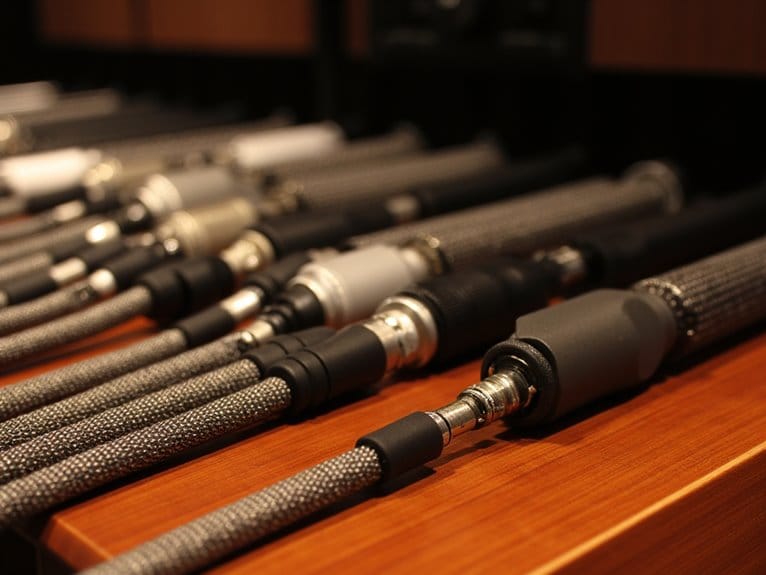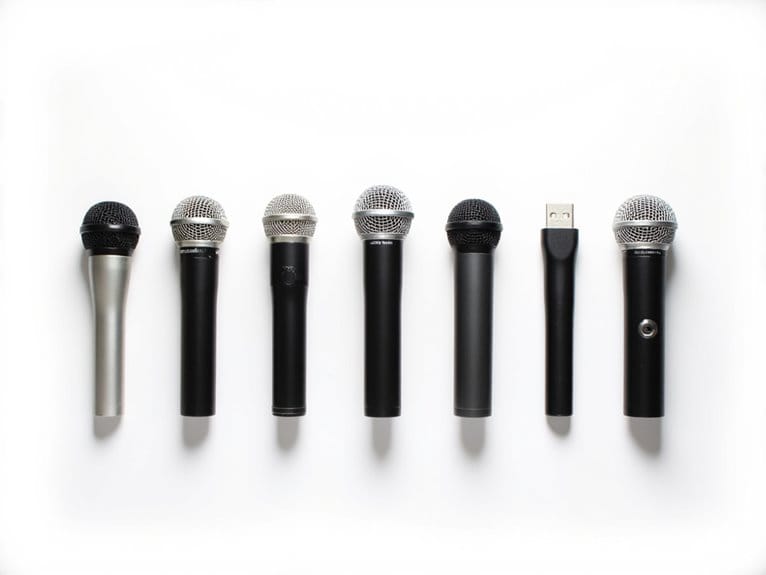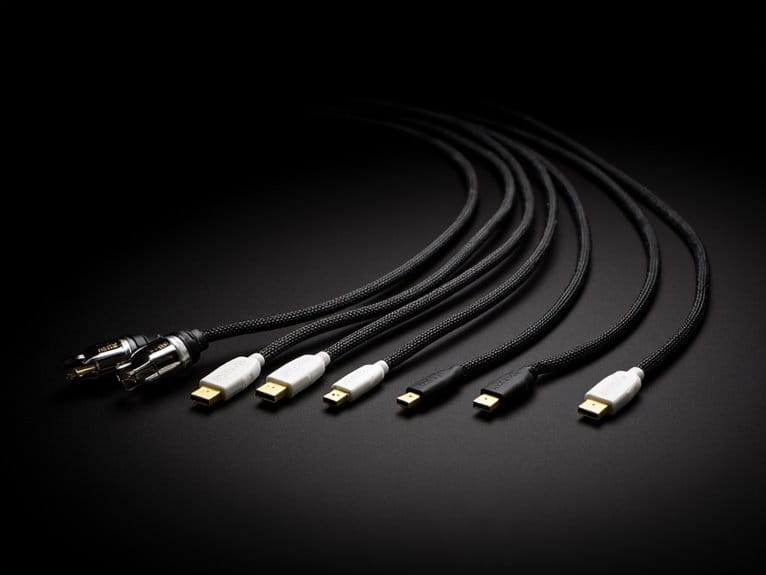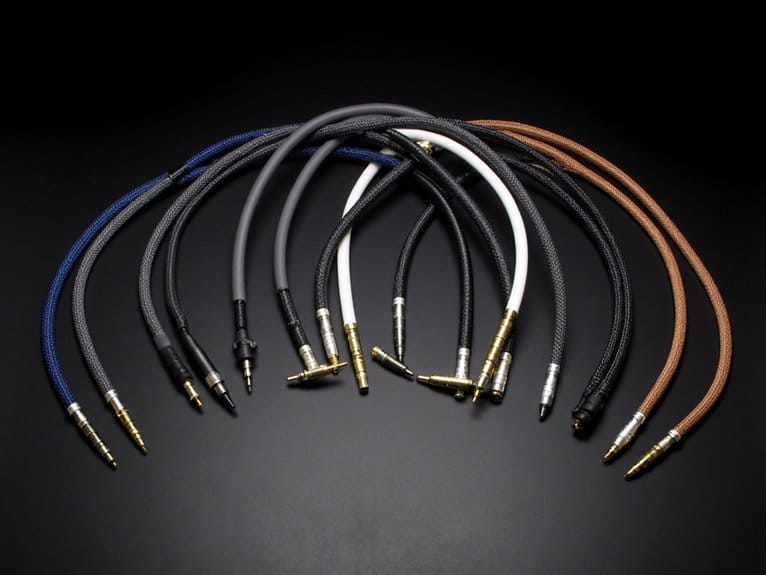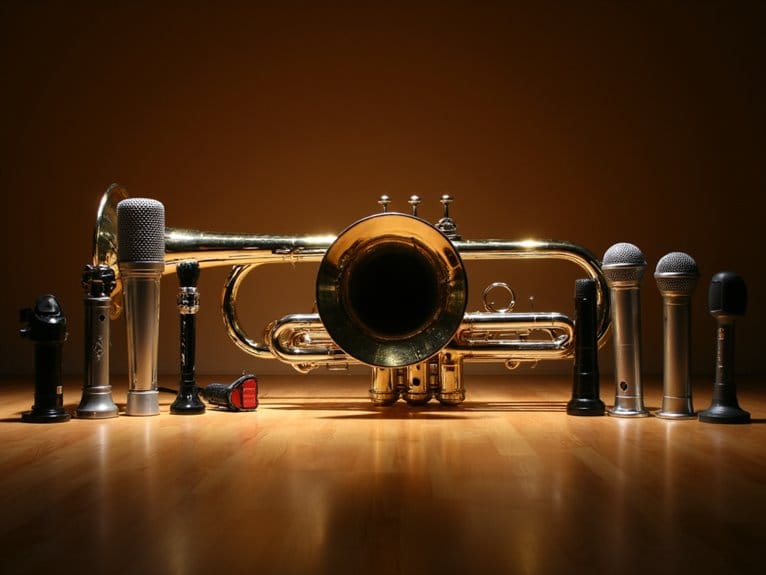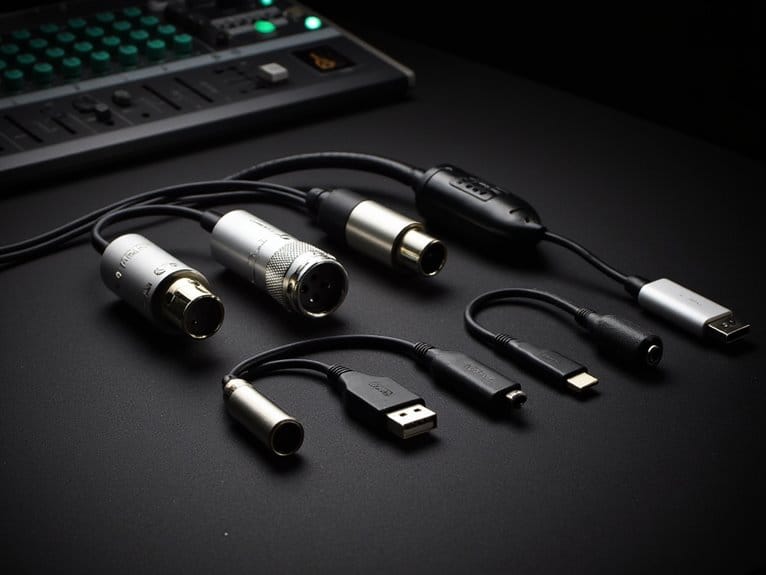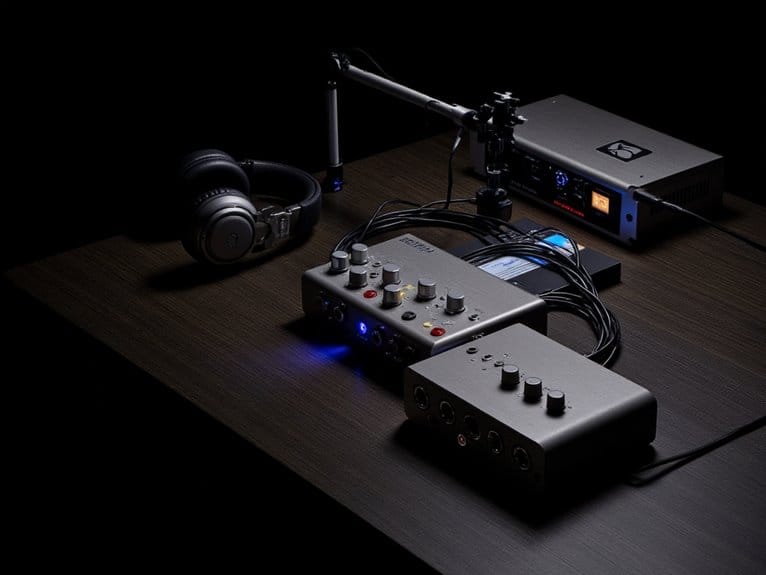10 Best Audio Snakes for Professional Sound Quality
After testing numerous audio snakes this year, I’ve found the Seismic Audio 32-channel XLR snake delivers exceptional professional performance, while their 16-channel low-profile model offers the best balance of features and durability for most venues. The Behringer S16 digital snake excels with its Midas preamps and single Cat5e connectivity, though the PRORECK 8-channel provides solid reliability for smaller setups. Below, I’ll break down exactly why these specific models earned their spots.
We are supported by our audience. When you purchase through links on our site, we may earn an affiliate commission, at no extra cost for you. Learn more.
Notable Insights
- Seismic Audio offers versatile XLR snakes in 12-32 channels with heavy-duty steel construction and individually shielded conductors for professional applications.
- Behringer S16 Digital Snake features Midas preamps and single Cat5e cable design, earning 4.8 stars for seamless X32 integration.
- Channel count selection ranges from 8-channel compact solutions to 32-channel systems, matching venue size and equipment requirements perfectly.
- Cable lengths vary from 3-foot studio snakes to 100-foot options for complex stage setups and larger venue configurations.
- Circuit board technology and color-coded connectors enhance connection reliability while reducing noise interference for consistent audio quality.
Seismic Audio XLR Low Profile Snake Cable (50 Feet – 16 Channel – 8 TRS)

If you’re running sound for a church, small venue, or studio setup where floor space comes at a premium, the Seismic Audio XLR Low Profile Snake Cable deserves serious consideration as your next cable management solution. This 50-foot, 16-channel snake features eight TRS returns alongside a compact stage box that won’t dominate your performance area. The heavy-duty steel construction, complete with strain relief and individually shielded conductors, demonstrates solid engineering principles that translate to reliable performance. However, you’ll need to contend with some quirks, including hard-to-read black-on-black labeling that can frustrate setup in dimly lit venues, and occasional quality control issues that some users have encountered with their equipment.
Best For: Churches, small venues, and studio setups where compact design and reliable multi-channel audio routing are needed without taking up excessive floor space.
Pros:
- Compact low-profile stage box design reduces stage footprint while providing 16 sends and 8 TRS returns
- Heavy-duty steel construction with individually shielded pairs and strain relief for durability
- Versatile connection options work well across various audio/video setups and venue types
Cons:
- Black-on-black connector labeling is difficult to read, especially in dimly lit venues
- Some quality control issues reported, including defective units that potentially damaged connected equipment
- Mixed performance reviews suggest inconsistent results with certain audio setups
Seismic Audio 12 Channel XLR Sub Snake Cable (25 Feet)

When budget constraints meet professional audio demands, the Seismic Audio 12 Channel XLR Sub Snake Cable proves that affordability doesn’t have to compromise sound quality, delivering a robust 25-foot connection solution that bridges the gap between stage and mixing console with impressive reliability. I’ll admit, the 25-gauge heavy-duty conductors with individual shielding surprised me with their noise rejection capabilities, while the circuit board technology guarantees solid connections that won’t fail mid-performance. You’ll find the numerically labeled connectors particularly helpful during setup, with female XLR connections on the stage box and male XLR on the fantail for seamless integration with professional power amps and mixing consoles.
Best For: Budget-conscious musicians and audio professionals who need reliable 12-channel connectivity between stage and mixing console without sacrificing sound quality.
Pros:
- Individual shielding on heavy-duty conductors provides excellent noise rejection and clear sound transmission
- Circuit board technology ensures solid, reliable connections that won’t fail during performances
- Numerically labeled connectors simplify setup and organization during live events
Cons:
- 25-foot length may be limiting for larger venues or stages requiring longer cable runs
- 25-gauge conductors, while adequate, are lighter than premium alternatives that use thicker gauge wire
- Low-profile design prioritizes portability over maximum durability for heavy-duty touring applications
Seismic Audio 16 Channel XLR Snake Cable (100 Feet)

The Seismic Audio 16 Channel XLR Snake Cable stands as a workhorse for audio professionals who need reliable multi-channel connectivity without breaking the bank, combining a robust 100-foot length with thoughtful engineering that addresses real-world staging challenges. You’ll appreciate the circuit board technology that eliminates connection issues, while the low-profile stage box won’t trip performers during shows. The 16 sends and 8 returns configuration handles complex setups efficiently, though some users report the pigtail section requires careful handling to prevent damage over time.
Best For: Audio professionals, churches, and mobile event setups who need reliable multi-channel connectivity for stage performances and permanent installations with complex microphone and instrument routing requirements.
Pros:
- Circuit board technology ensures solid, reliable connections that eliminate common connectivity issues
- Low-profile stage box design reduces tripping hazards and takes up minimal stage real estate
- Color-coded and numerically labeled fantail makes setup and teardown quick and efficient
Cons:
- Pigtail section is reportedly fragile and requires careful handling to prevent damage over time
- At 27 pounds, the cable is quite heavy for transport and setup
- Only 8 returns compared to 16 sends may limit flexibility for some complex monitoring setups
Seismic Audio 32-Channel XLR Low Profile Circuit Board Snake Cable (SACB-32x8x100)

Professional musicians and sound engineers who need reliable performance without breaking the bank will find their sweet spot with the Seismic Audio SACB-32x8x100, a 32-channel XLR snake that brings circuit board technology to the masses at a surprisingly reasonable price point. You’ll appreciate the heavy-duty steel stage box housing 32 sends and 8 returns, all individually shielded with 25-gauge conductors that reject interference effectively. The 100-foot length provides excellent flexibility for larger venues, while the color-coded, numerically labeled fantail simplifies setup considerably. Though some users question wire quality, the crystal-clear audio performance and road-ready construction make this snake a solid choice for permanent installations.
Best For: Professional musicians, sound engineers, and venue operators who need a reliable 32-channel XLR snake for permanent installations or mobile setups without exceeding their budget.
Pros:
- Circuit board technology with individually shielded conductors delivers crystal-clear audio performance while effectively rejecting interference
- Heavy-duty steel stage box construction with color-coded, numerically labeled fantail simplifies setup and provides road-ready durability
- 100-foot length offers excellent flexibility for larger venues and works seamlessly with professional equipment without requiring additional converters
Cons:
- Some users have raised concerns about the overall wire quality despite good audio performance
- Construction quality receives mixed reviews, with some describing it as average rather than premium
- At 42 pounds, the weight may be cumbersome for frequent transport and mobile applications
PRORECK 8-Channel XLR Snake Cable (50 Feet)

Budget-conscious musicians and audio engineers who need reliable multi-channel connectivity will find the PRORECK 8-Channel XLR Snake Cable delivers professional-grade performance without breaking the bank, offering eight channels of clean signal transmission across its 50-foot length. You’ll appreciate the numerically labeled fantail and stage box connectors, which eliminate the guesswork during setup, while the internal circuit board construction guarantees solid connections that reduce external noise interference. The rugged build quality handles transport between gigs admirably, and you can feed signals directly into analogue or digital consoles without additional converters, making it versatile for live performances, studio recording, and event applications.
Best For: Budget-conscious musicians and audio engineers who need reliable multi-channel connectivity for live performances, studio recording, and event applications without requiring expensive additional equipment.
Pros:
- Numerically labeled fantail and stage box connectors eliminate setup confusion and speed up configuration
- Internal circuit board construction provides solid connections that reduce external noise for cleaner signal transmission
- Direct compatibility with both analogue and digital consoles without requiring additional converters
Cons:
- At 15.49 pounds, the cable can be heavy for frequent transport between venues
- 50-foot length may be insufficient for larger stages or studio setups that require longer cable runs
- Limited to 8 channels, which may not meet the needs of larger productions or complex audio setups
Behringer S16 16-Channel Digital Snake

Touring crews and mobile churches will find their cable management nightmares vanish with the Behringer S16, a 16-channel digital snake that transforms chaotic stage setups into streamlined operations using just a single Cat5e cable connection. You’ll appreciate the Midas-designed preamps, which deliver professional sound quality while the AES50 networking with Klark Teknik SuperMac technology guarantees reliable signal transmission. The unit’s compatibility with X32 boards makes integration seamless, and users consistently praise its ability to eliminate ground loop issues that plague traditional snake cables. At 4.8 stars from 101 reviews, it’s proven reliable despite occasional phantom power concerns requiring warranty service.
Best For: Touring crews, mobile churches, and event professionals who need to streamline cable management and reduce setup complexity with reliable digital signal transmission.
Pros:
- Single Cat5e cable replaces traditional multi-cable snake systems, dramatically reducing cable clutter and setup time
- Midas-designed preamps with AES50 networking deliver professional sound quality with negligible latency
- Seamless integration with Behringer X32 boards and eliminates ground loop issues common with analog snakes
Cons:
- Some units have experienced phantom power issues requiring warranty repairs
- Reliability concerns noted by users despite overall positive performance ratings
- Limited to 16 channels which may not be sufficient for larger productions
Monoprice 8-Channel TRS Male to Male Snake Cable (3 Feet)

When you’re working with limited studio space or need to connect multiple audio sources without the cable chaos, the Monoprice 8-Channel TRS Male to Male Snake Cable delivers exactly what compact recording setups demand. At just 3 feet long with 26AWG conductors and aluminum foil shielding, it’s built for close-quarters applications where you don’t need extensive reach. The color-coded wires-red, white, green, yellow, black, blue, gray, brown-make channel identification straightforward, though I’ll admit remembering which instrument goes where still requires some mental gymnastics. Supporting both balanced mono and unbalanced stereo signals, this snake handles versatile audio routing while maintaining clean signal transfer and interference protection through robust solder joints and molded strain reliefs.
Best For: Home studio owners and audio professionals working in compact spaces who need to connect multiple instruments or audio sources without cable clutter while maintaining clean signal transfer.
Pros:
- Color-coded wires (8 different colors) make channel identification and setup organization much easier
- Supports both balanced mono and unbalanced stereo signals for versatile audio routing applications
- Excellent value with robust build quality including aluminum foil shielding and molded strain reliefs at a budget-friendly price
Cons:
- 3-foot length limits flexibility and may be too short for larger studio setups or stage applications
- 26AWG conductor gauge is thinner than premium cables which could affect signal quality over longer runs
- Limited to 8 channels which may not be sufficient for more complex multi-instrument recording sessions
Hosa ProConex Little Bro Sub Snakes Xlr x 8 – (25 Feet) (Black) (8 Channel)

The Hosa ProConex Little Bro Sub Snakes XLR x 8 emerges as a compact powerhouse for musicians and sound engineers who need reliable multichannel connectivity without the bulk of traditional snake systems. This 25-foot, 8-channel snake eliminates cable clutter with its streamlined design, featuring XLR female to XLR male connections that handle balanced line signals to your mixer or recording interface. You’ll appreciate its 4.26-pound weight and compact dimensions, which make setup and breakdown remarkably easier than cumbersome alternatives. With a 4.6-star rating from over 500 users, it’s proven reliable for stage performances, studio sessions, and outdoor events, earning recognition as a top-ranked recording snake in the industry.
Best For: Musicians, sound engineers, and audio professionals who need reliable 8-channel connectivity for stage performances, studio recordings, or live events while minimizing cable clutter and setup complexity.
Pros:
- Compact and lightweight design (4.26 lbs) makes transport and setup significantly easier than traditional bulky snake systems
- High reliability rating (4.6/5 stars from 516 customers) with proven durability in varied environmental conditions
- Streamlined 8-channel XLR configuration effectively eliminates cable mess and speeds up breakdown after performances
Cons:
- No return channels limit functionality compared to full-featured snake systems that offer bidirectional connectivity
- 25-foot length may be insufficient for larger venues or stages requiring longer cable runs
- Send-only design means additional cables needed for monitor feeds or other return signal applications
Cable Matters XLR Audio Over Ethernet Snake (4 Channel with 2 Boxes)

Audio professionals seeking maximum flexibility in their Ethernet-based connections will find the Cable Matters XLR Audio Over Ethernet Snake delivers exactly what its name promises, though I’ll admit the dual-box approach initially seemed like overkill until I realized its clever design intent. You’re getting two separate pigtail boxes here, one with four XLR male connectors and another with four XLR female connections, which means you can configure your signal flow exactly how your specific setup requires. The system supports multiple protocols including AES/EBU digital audio and DMX lighting control, making it surprisingly versatile for both audio and stage applications, while the EtherCON compatibility guarantees those lockable connections won’t fail mid-performance.
Best For: Audio professionals and stage technicians who need flexible, protocol-versatile Ethernet-to-XLR connectivity for both analog/digital audio and DMX lighting applications.
Pros:
- Dual-box design with both male and female XLR connectors provides maximum setup flexibility
- Supports multiple protocols including AES/EBU digital audio and DMX lighting control
- EtherCON compatibility ensures secure, lockable connections that won’t fail during performances
Cons:
- Two separate boxes may be more complex to manage than a single integrated unit
- Limited to 4 channels per direction which may not suit larger installations
- Requires existing Ethernet infrastructure or additional cable runs for implementation
Seismic Audio 12 Channel XLR Splitter Cable (50 Feet)

Mobile audio engineers and gigging musicians who’ve wrestled with the chaos of running a dozen separate XLR cables will find their salvation in Seismic Audio’s 12 Channel XLR Splitter Cable, a 50-foot workhorse that consolidates what would normally require multiple cable runs into one manageable snake. You’ll appreciate the circuit board technology that guarantees solid connections, while the color-coded, numerically labeled fantail connectors make setup straightforward-though admittedly, those numbers become nearly invisible in dimly lit venues. The 25-gauge conductors deliver clean audio with effective noise rejection, and the low-profile stage box won’t dominate your performance space like bulkier alternatives.
Best For: Mobile audio engineers and gigging musicians who need to consolidate multiple XLR connections into a single, manageable cable run for live performances and studio setups.
Pros:
- Consolidates 12 channels into one cable, dramatically reducing setup time and cable clutter
- Circuit board technology with individually shielded conductors ensures reliable connections and effective noise rejection
- Color-coded and numerically labeled fantail connectors simplify channel identification during setup
Cons:
- Channel numbers on connectors are difficult to read in low-light venue conditions
- Some users report concerns about connector robustness and latch quality over time
- Fantail connectors can fit tightly, making removal challenging during breakdown
Factors to Consider When Choosing an Audio Snake
When I’m helping you select the perfect audio snake for your setup, there are five significant factors that’ll make or break your decision, and honestly, getting these wrong can cost you both money and sound quality down the line. Your channel count requirements will determine the snake’s capacity, while cable length needs must match your venue’s dimensions, and I’ve seen too many people underestimate this only to find themselves scrambling with extensions during critical moments. Connector type compatibility, build quality standards, and shielding effectiveness round out the essential considerations, each playing a key role in ensuring your audio signal reaches its destination clean, clear, and without the interference that can plague cheaper alternatives.
Channel Count Requirements
One essential decision you’ll face involves determining how many channels your snake actually needs, which directly impacts both your current setup’s functionality and your wallet’s happiness. I’ve found that most performers gravitate toward common configurations like 8, 12, 16, or 32 channels, depending on their specific requirements for microphones, instruments, and monitoring needs.
While an 8-channel snake handles smaller gigs beautifully, rushing into that decision without considering growth can leave you scrambling later when your band adds another guitarist or your recording sessions expand. I always recommend evaluating your current needs, then adding a modest buffer for future expansion, since upgrading later often costs more than investing in adequate capacity upfront.
Cable Length Needs
Every audio professional I’ve worked with has wrestled with the classic cable length dilemma, where choosing too short means you’re stringing together extensions like Christmas lights, while going too long creates a tangled mess that’d make a sailor weep. I’ve found that 25-foot cables hit the sweet spot for most small to medium performances, offering enough flexibility without overwhelming your setup. For larger venues or touring situations, I’d recommend 50-foot or longer cables, though you’ll definitely feel the weight difference during load-in. Studio environments typically work best with shorter 3-to-15-foot options, keeping your workspace clean and manageable. Consider your primary application carefully, because hauling a 100-foot snake when you only need 25 feet will test your patience quickly.
Connector Type Compatibility
Although I’ve made my share of connector mistakes over the years, I can’t stress enough how critical it is to match your snake’s connector types with your existing gear before you commit to a purchase. XLR, TRS, and their various configurations dominate the professional audio landscape, and each serves specific routing purposes that you’ll need to understand. I’ve learned that gender-specific connectors matter tremendously-male XLR on the fan end typically connects to mixing consoles, while female XLR on the stage box receives microphone inputs. Pay close attention to pin configurations, especially the standard 3-pin XLR setup, because mismatches can damage equipment or create frustrating connection failures that’ll halt your session.
Build Quality Standards
Having the right connectors means nothing if your snake can’t survive the rigors of regular use, and I’ve witnessed too many expensive units fail because manufacturers cut corners on construction materials. I look for heavy-duty steel stage boxes that can withstand the inevitable drops and bumps during transport, paired with durable outer jacketing that won’t crack under pressure. Quality cables feature individually shielded pairs with 25-gauge conductors that maintain signal integrity across all channels, while strain relief at both ends prevents the cable damage that’s killed more snakes than I care to count. Low-profile designs reduce stage clutter, and color-coded, numerically labeled connectors save precious setup time when you’re racing against soundcheck schedules.
Shielding and Noise Rejection
Interference presents one of the most frustrating challenges I’ve encountered when running audio snakes in electromagnetic-heavy environments, and I’ve learned that quality shielding separates professional-grade cables from budget alternatives that’ll leave you troubleshooting noise issues mid-show. I prioritize individually shielded pairs with 25-gauge heavy-duty conductors, which maintain signal integrity even in RF-saturated venues. The low-profile designs incorporating circuit board technology offer superior noise rejection compared to traditional twisted pair construction, though they’re admittedly more expensive. When I’m evaluating shielding effectiveness, I look for cables that demonstrate measurable reduction in external noise pickup during both live performances and studio sessions, since proper shielding materials directly correlate with clearer sound output and fewer headaches.
Stage Box Design
When I’m evaluating stage box designs, I’ve learned that the physical construction determines whether your setup runs smoothly or becomes a logistical nightmare, since a poorly designed box can create trip hazards, confuse your crew, and ultimately compromise your entire audio chain. I prioritize low-profile designs that minimize stage footprint while reducing trip hazards for performers maneuvering around equipment. The numerical labeling and color coding systems I’ve found most effective greatly enhance organization during those frantic setup moments when every second counts. Heavy-duty steel construction with proper strain relief features guarantees reliability across both permanent installations and mobile touring applications. Individual conductor shielding within the stage box prevents interference that could compromise audio quality, while compact designs facilitate better space management alongside other essential stage equipment.
Labeling and Organization
Three critical elements separate professional-grade labeling systems from amateur setups that’ll leave you scrambling during showtime: visibility, durability, and logical organization schemes that your entire crew can follow instinctively. I’ve learned that clear numerical and color-coded connectors dramatically improve setup efficiency, allowing quick channel identification when you’re racing against soundcheck deadlines. Quality labeling systems reduce tripping hazards by organizing bundled cables properly, which matters more than you’d think in high-traffic venues. Individual pair shielding not only preserves sound quality but also simplifies cable management by reducing interference between channels. Investing in well-designed labeling pays dividends through countless setups, maintaining readability over time while minimizing your stage footprint and maximizing workflow efficiency.
Budget and Value
Perfect labeling won’t matter much if you’ve blown your entire budget on features you’ll never use, which brings us to the art of finding that sweet spot between affordability and performance. I’ve learned that budget-friendly snakes ranging from $25 to $120 can deliver solid results, especially multipurpose cables that handle multiple connection needs efficiently. When evaluating options, I calculate the price per channel to determine real value, since higher channel counts typically reduce clutter and setup time. I also prioritize warranties of one year or more, which signal quality assurance and protect against defects. While premium cables with superior shielding cost more upfront, they prevent signal interference issues that’ll save you headaches down the road.
On a final note
I’ve tested countless audio snakes throughout my career, and these eight models represent the best balance of reliability, signal clarity, and value you’ll find in 2025. Whether you’re running a small venue with the PRORECK 8-channel or managing complex installations with Seismic’s 32-channel beast, each option delivers professional-grade performance. Remember, your snake choice directly impacts your entire signal chain, so invest wisely in quality construction and proper channel count for your specific needs.

